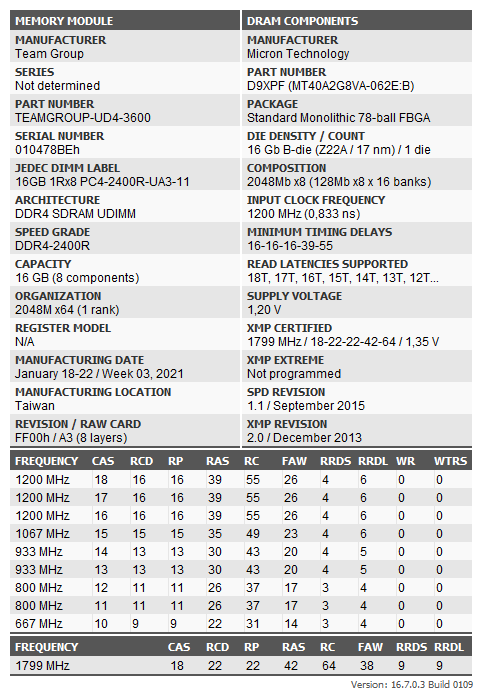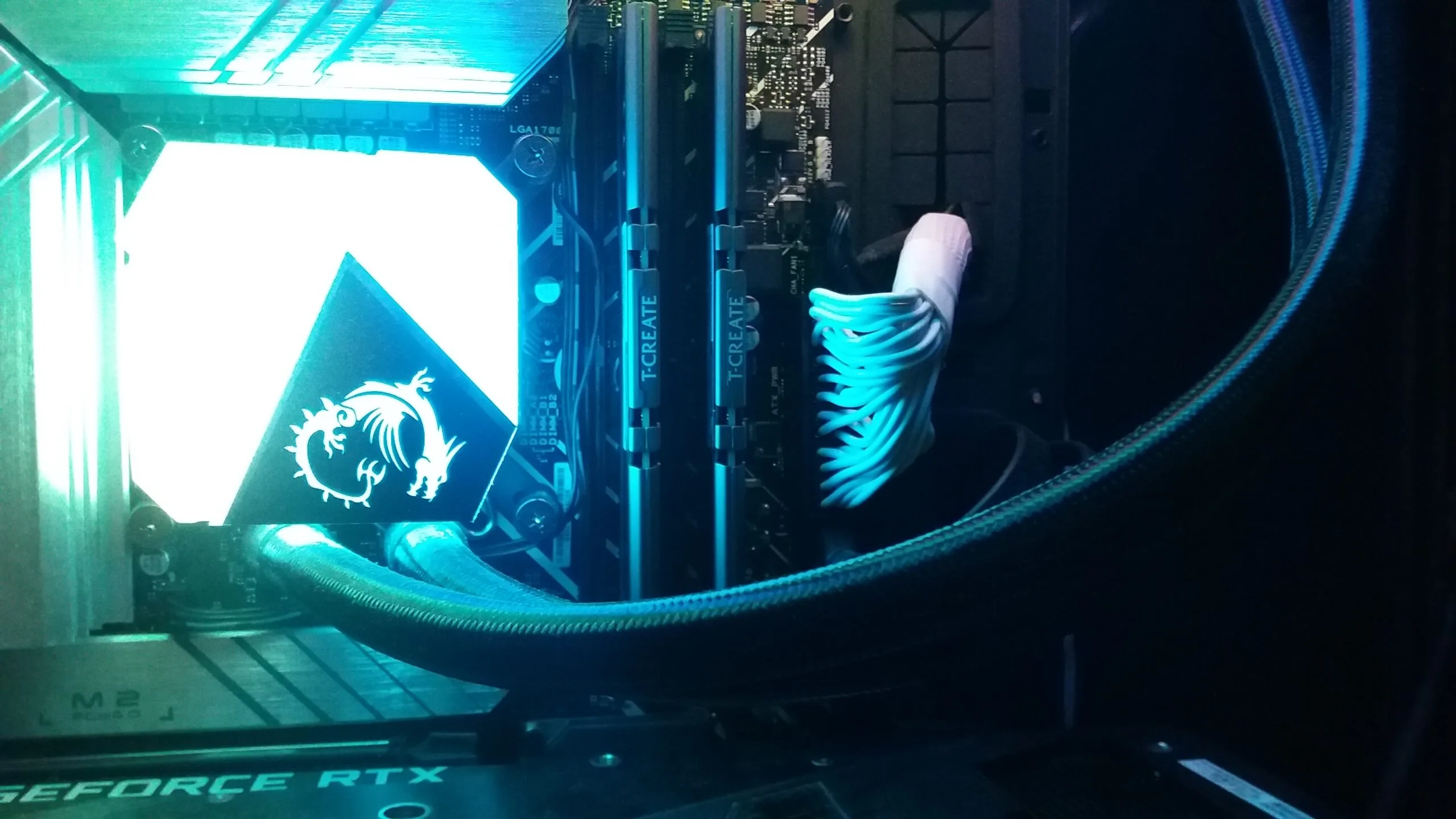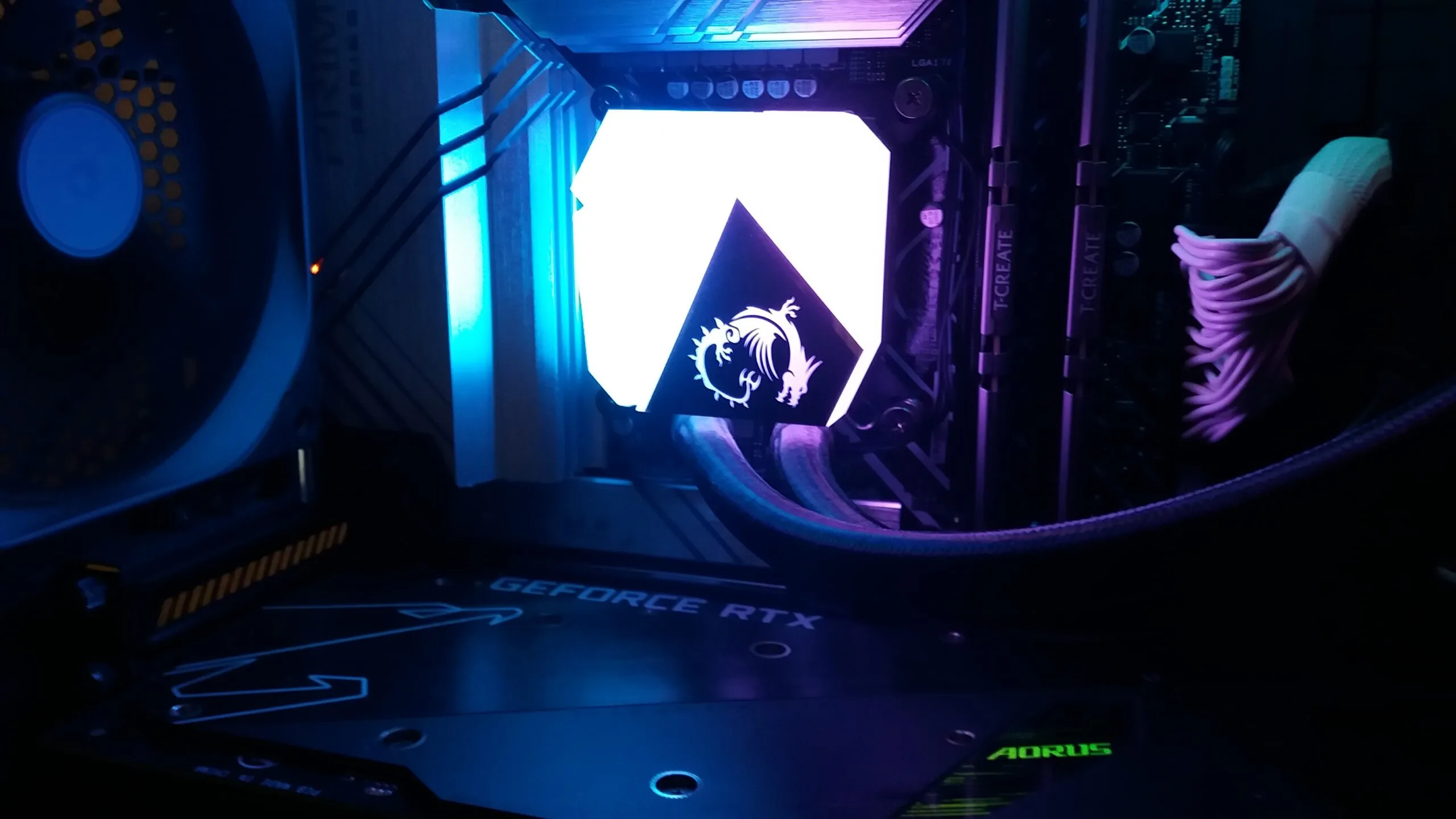TeamGroup T-CREATE EXPERT DESKTOP DDR4 OC10L 3600MHz CL18 2x16GB Kit Review – Made To Create, but Worth It for Gaming?
T-CREATE EXPERT DESKTOP DDR4 OC10L 3600MHz CL18 is a quality and fast 2×16 GB memory kit for professional creators that we are reviewing to feature its overall performance potential and see how it compares versus a gaming kit on an i9-12900K/Z690 platform. We received a review sample from TeamGroup, who told us that we should have no issues reaching the advertised 3600MHz frequency by using its XMP 2.0 profile on our CPU platform. We will search for its maximum stable and safe overclock and compare its performance against our T-FORCE XTREEM ARGB WHITE DDR4-3600MHz 2x16GB premium gaming memory kit.
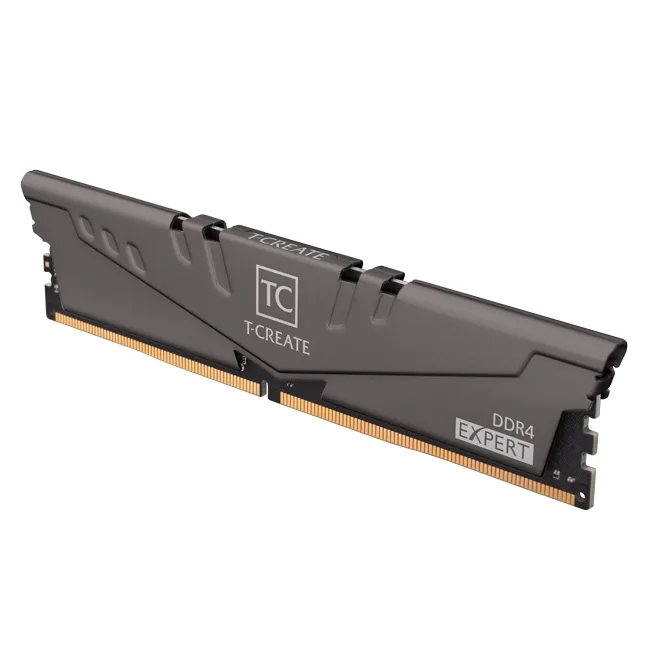
Our usual benchmarking PC features 2x16GB of T-FORCE XTREEM ARGB WHITE DDR4 CAS Latency (CL) 14 memory at 3600MHz (XMP profile). We will chart its performance data and check if the T-CREATE EXPERT DESKTOP DDR4 OC10L kit is a good option for creators who want satisfying performance while gaming too.
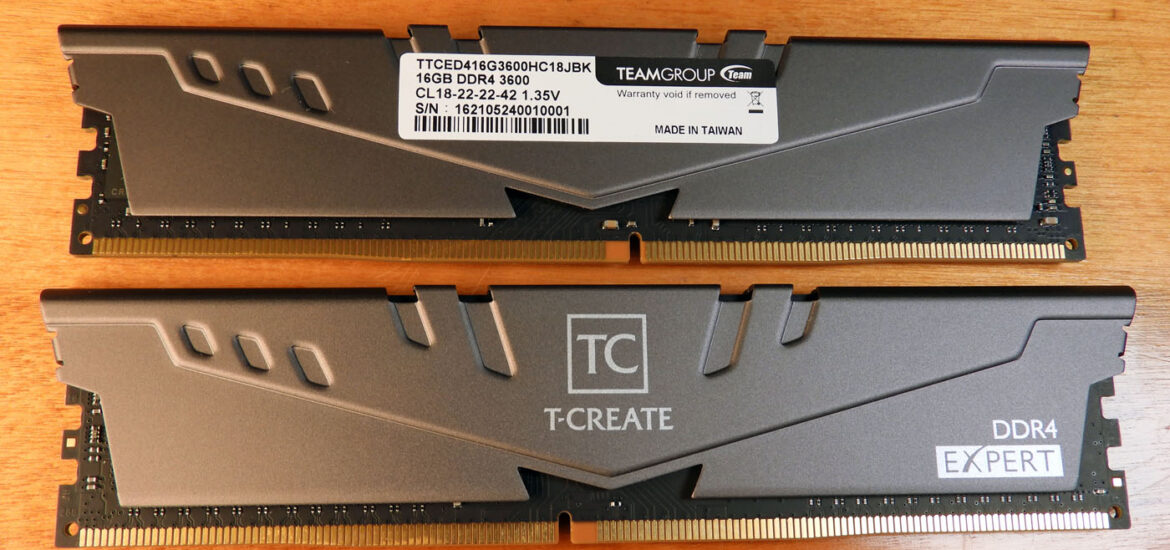
Here are the memory kits that we are comparing:
- TeamGroup T-CREATE EXPERT DESKTOP DDR4 OC10L PC4-28800 DDR4-3600MHz CL18 2x16GB kit
- TeamGroup T-FORCE XTREEM ARGB WHITE PC4-28800 DDR4-3600MHz CL14 2x16GB kit
The T-CREATE EXPERT DDR4-3600 CL18 2x16GB kit is $111.99 at Amazon.com.
Testing Platform
Our testing platform is a recent clean install of Windows 11 Pro 64-bit, using a 12th Gen Intel Core i9-12900K at stock settings, an ASUS PRIME Z690-P D4 motherboard, a Samsung 500GB SSD 960 EVO NVMe M.2, two WD Blue 1TB SATA SSDs, a TeamGroup MP33 M.2 PCIe 1TB SSD, and 32GB T-CREATE EXPERT DDR4-3600MHz, or T-FORCE XTREEM ARGB WHITE DDR4-3600MHz. We used the Gigabyte AORUS RTX 3080 MASTER at stock clocks for our testing. The settings, benchmarks, and hardware are identical except for the two DDR4 kits and memory latency profiles we compare.
The Command Rates of these two memory kits are 2T by their respective default XMP profiles. The T-CREATE EXPERT is rated CL18-22-22-42 and 1.35V using its XMP profile, and the T-FORCE XTREEM ARGB WHITE is CL14-15-15-35 and 1.45V (XMP profile). We will compare the T-CREATE EXPERT performance versus T-FORCE XTREEM ARGB WHITE to chart the effect of their different XMP timings on the performance of 3 modern PC games: F1 2021, Far Cry 6, and Horizon Zero Dawn at maxed-out/ultra 1920×1080 resolution. We benchmark using multiple well-respected memory-related benchmarking tools such as AIDA64, Blender, Cinebench, Geekbench, Novabench, Sandra, 3DMark, and 7-Zip.
Product Specifications & Features
Here are the memory specifications of the T-CREATE EXPERT DDR4-3600MHz from the TeamGroup website:
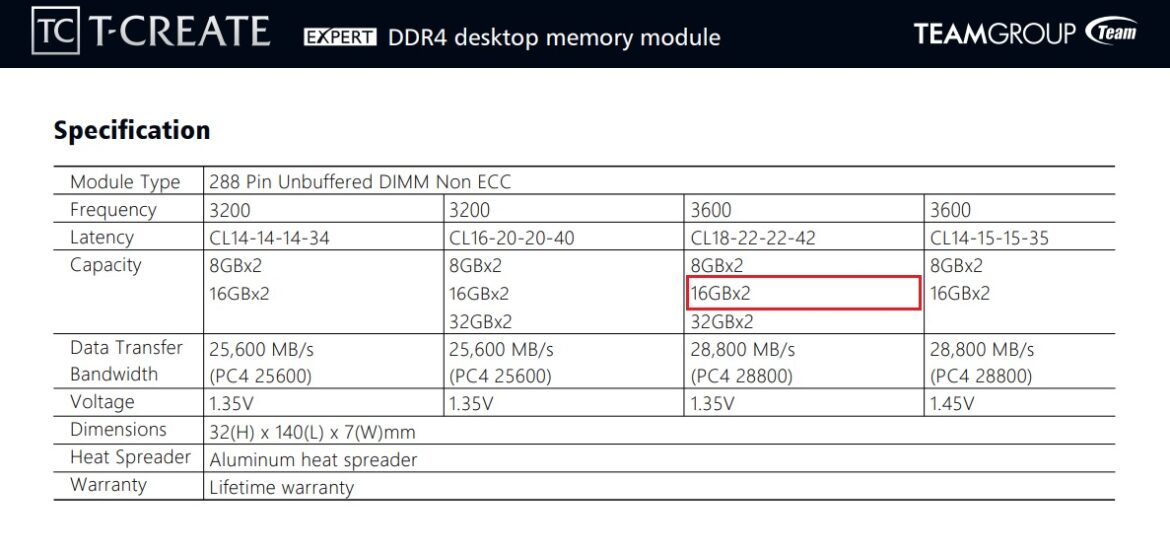
Below you can also see a summary of the memory specifications from the Thaiphoon Burner tool:
Using its default XMP profile, the voltage is automatically set at 1.35V for 3600MHz, but may be manually adjusted in the BIOS from between 1.20V to 1.50V – or higher. Here are the EXPERT DESKTOP DDR4 features as taken from TeamGroup’s website.
Features
- Large capacity, overclocking, and stability all in one
- 10-layer board with professional anti-interference
- Customized high-temperature resistant capacitor
- High-efficiency multitasking
TeamGroup offers a lifetime warranty for their T-CREATE desktop memory, and EXPERT DESKTOP DDR4 is available only in titanium grey color.

Unboxing
The T-CREATE EXPERT DDR4-3600MHz 2x16GB memory kit comes in a compact and moderately slim box with a soft touch that advertises its features on both upper and bottom faces and the specs on its reverse only.
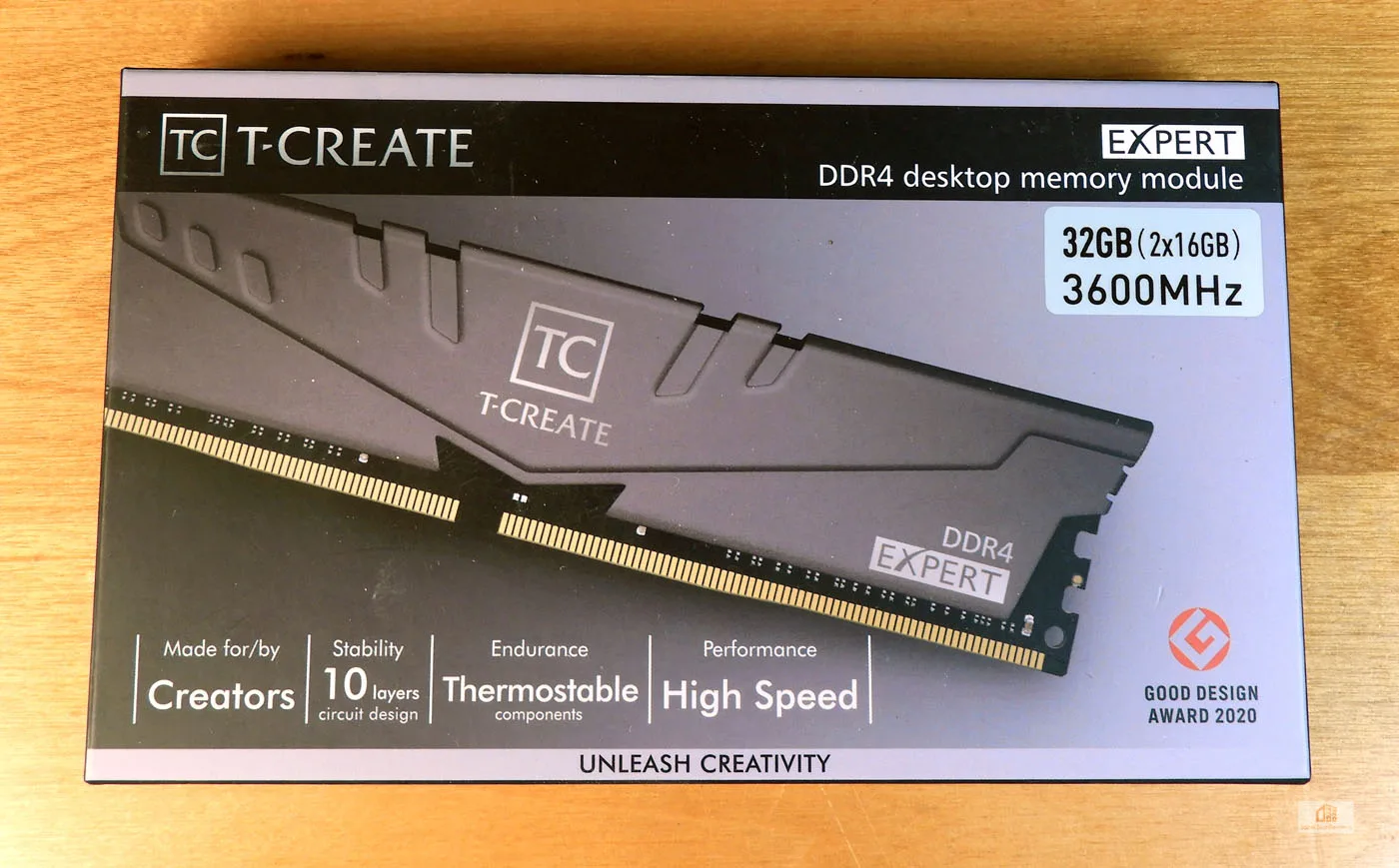
 Once you open the box, you see the two memory modules inside an anti-static plastic clamshell.
Once you open the box, you see the two memory modules inside an anti-static plastic clamshell.
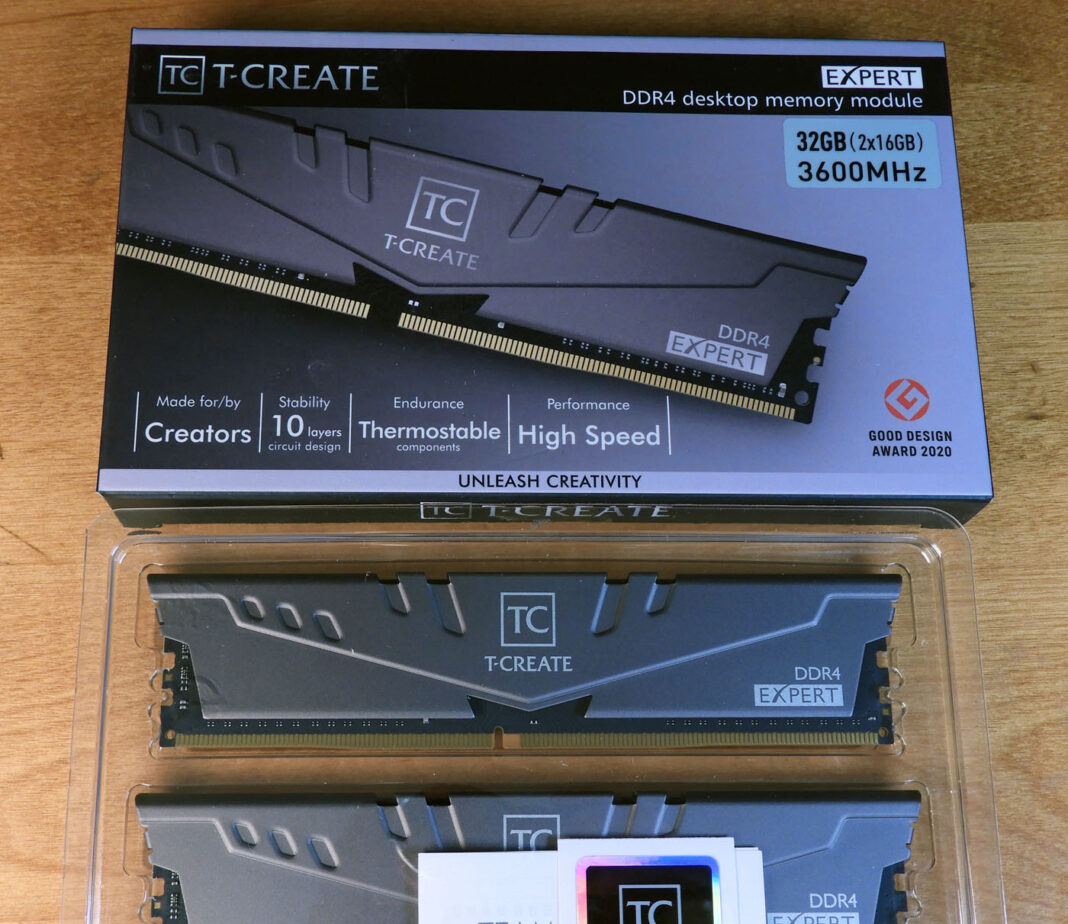 The plastic clamshell also includes the warranty and installation guide, and a sticker with the T-CREATE logo.
The plastic clamshell also includes the warranty and installation guide, and a sticker with the T-CREATE logo.
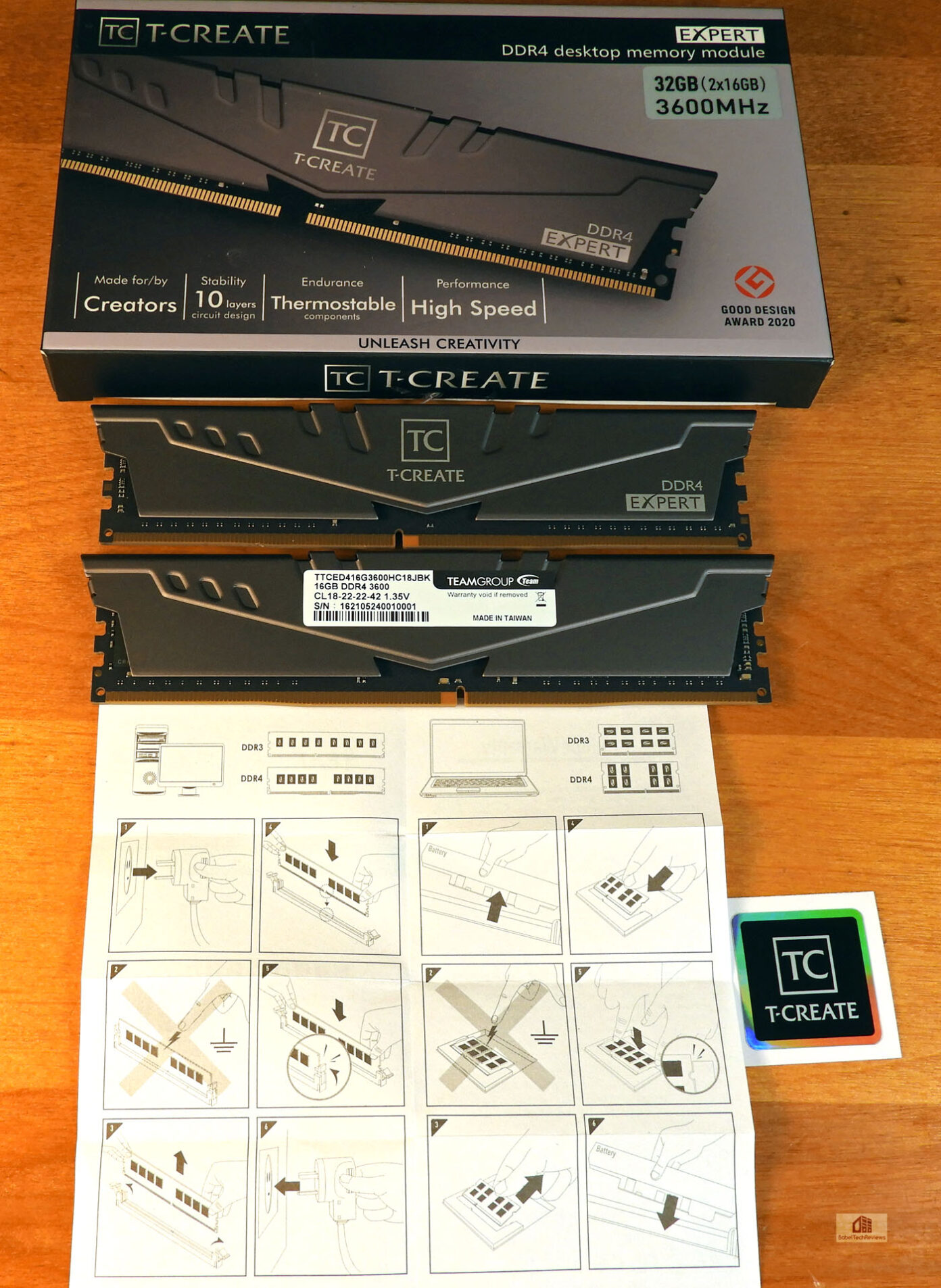 On the front of the modules, we see a printed T-CREATE logo over a sober titanium grey heatsink. “T-CREATE” is also printed in a soft silvery-grey font on its profiles, and “EXPERT” and “DDR4” are printed on the front.
On the front of the modules, we see a printed T-CREATE logo over a sober titanium grey heatsink. “T-CREATE” is also printed in a soft silvery-grey font on its profiles, and “EXPERT” and “DDR4” are printed on the front.
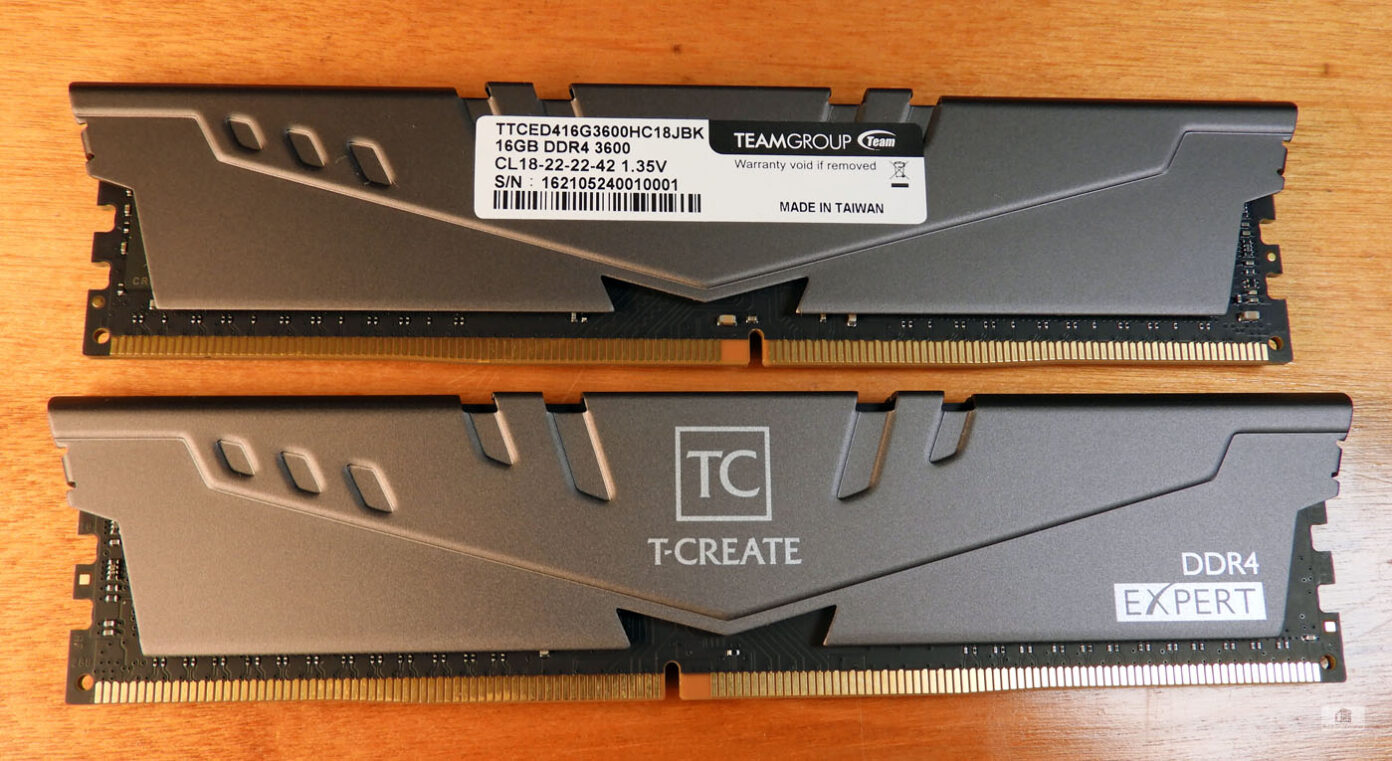
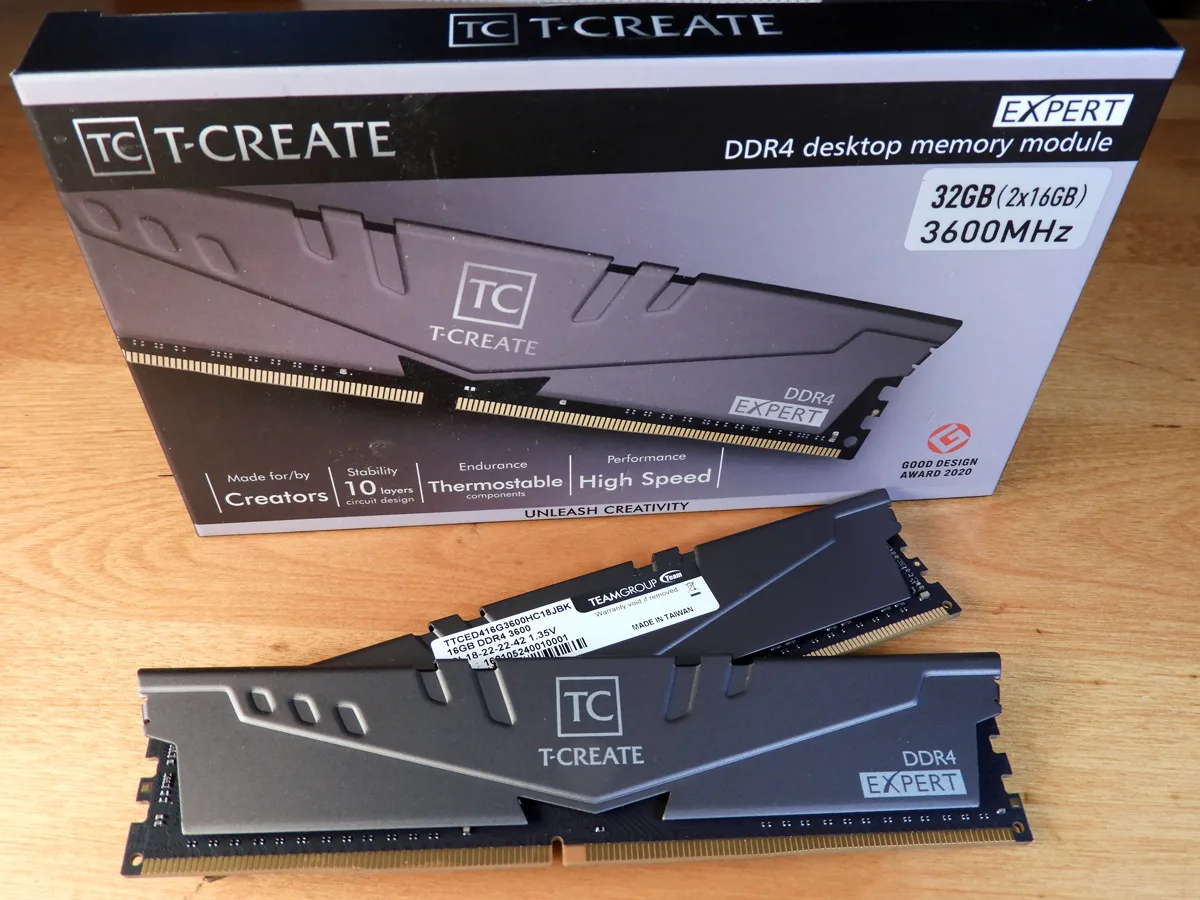 The T-CREATE EXPERT DDR4-3600MHz modules feature a quality build, a sober but elegant style design, and look great once installed in our conservative – not very RGB-focused – gaming rig.
The T-CREATE EXPERT DDR4-3600MHz modules feature a quality build, a sober but elegant style design, and look great once installed in our conservative – not very RGB-focused – gaming rig.
Before sharing our overclocking experience and offering the performance data and charts of each different analysis scenario, it’s important to describe both the hardware and software configuration used in our testing, as well as the analysis methodology.
Benching Methodology
Test Configuration – Hardware
- 12th Gen Intel Core i9-12900K (Hyper-Threading/Turbo boost on; stock settings)
- ASUS PRIME Z690-P D4 motherboard (Intel Z690 chipset, v.1008 BIOS)
- TeamGroup T-CREATE EXPERT DESKTOP DDR4 OC10L PC4-28800 DDR4-3600MHz CL18 2x16GB kit, supplied by TeamGroup
- TeamGroup T-FORCE XTREEM ARGB WHITE PC4-28800 DDR4-3600MHz CL14 2x16GB kit, supplied by TeamGroup
- Gigabyte AORUS GeForce RTX 3080 MASTER 10GB (rev. 1.0); v.F4 VBIOS, stock clocks
- 1 x Samsung 500GB SSD 960 EVO NVMe M.2
- 2 x WD Blue 1TB SATA SSD
- 1 x TeamGroup MP33 M.2 PCIe 1TB SSD
- Corsair RM850x, 850W 80PLUS Gold power supply unit
- MSI MAG Series CORELIQUID C280, ARGB CPU Liquid Cooler (AIO) 280mm CPU water cooler
- ASUS ROG Swift PG279Q 27? IPS QuadHD (2560 x 1440) 165Hz 4ms G-Sync Monitor
Test Configuration – Software
- NVIDIA GeForce 511.23 drivers; ‘High Quality’ and ‘prefer maximum performance’ (on a per-game profile-basis); Shader Cache Size ‘Unlimited’ (globally); fixed refresh rate (globally).
- Resizable BAR On
- V-Sync application controlled in the control panel, V-Sync off in-game
- AA and AF as noted in games; all in-game settings are specified
- Windows 11 64-bit Pro edition, latest updates v21H2, High-performance power plan, HAGS off, Game Mode, Game DVR & Game Bar features off, Control Flow Guard (CFG) off on a per-game basis.
- GIGABYTE and ASUS tools not installed
- Latest DirectX
- All 3 games are patched to their latest versions at the time of publication
- AIDA64 Extreme, v6.60.5923 Beta
- Blender Benchmark, v2.93.1
- CapFrameX (CX), the latest version
- Cinebench R23, the latest version
- CPU-Z, the latest version
- Geekbench 5, the latest version
- Karhu RAM Test, the latest version
- Novabench
- OCCT, the latest version
- RivaTuner Statistics Server (RTSS), the latest version
- SiSoftware Sandra Bussiness 2021, v31.75
- Super PI, the latest version
- Thaiphoon Burner, the latest version
- ISLC (Purge Standby List) before each benchmark, the latest version
- UL 3DMark’s benchmark suite, the latest version
- wPrime, the latest version
- 7-Zip, v21.07 (x64)
GeForce Driver Suite-related
- We use DCH Game Ready drivers
- The display driver is installed
- We install the latest version of PhysX
Frametimes Capture & Analysis tool-related
- CapFrameX is used for capturing and analyzing the relevant performance numbers obtained from each recorded built-in game benchmark sequence.
- Consecutive runs until detecting 3 valid runs (no outliers) that can be aggregated by CapFrameX using the following method:
- ‘Aggregate excluding outliers’:
- Outlier metric: Third, P0.2 (0.2% FPS percentile)
- Outlier percentage: 3% (the % the FPS of an entry can differ from the median of all entries before counting as an outlier)
- ‘Aggregate excluding outliers’:
Benchmark Suite
PC Game suite – Built-in Game Benchmarks
- F1 2021 (DX12)
- Far Cry 6 (DX12)
- Horizon Zero Dawn (DX12)
Synthetic Benchmarks
- AIDA64 Extreme – Cache And Memory Benchmark (Memory Tests)
- Read
- Write
- Copy
- Latency
- Geekbench 5 – CPU Benchmark
- Single-Core
- Multi-Core
- Novabench Test
- Global
- GPU
- RAM
- CPU
- SiSoftware Sandra Business 2021 – Memory Controller tests
- Memory Bandwidth
- Cache & Memory Latency
- Cache & Memory Bandwidth
- Memory Transaction Throughput
- Super PI Benchmark
- 16M test
- 32M test
- wPrime Benchmark
- 32M test
- 1024M test
- 7-Zip Benchmark
Hybrid Game Benchmarks
- 3DMark – Fire Strike (DX11)
- Overall
- Graphics
- Physics (CPU)
- Combined
- 3DMark – Time Spy (DX12)
- Overall
- Graphics
- CPU
Non-Synthetic/Real-World Benchmarks
- Blender Benchmark – All benchmark scenes
- Cinebench R23 Benchmark
- CPU (Multi-Core) test
- CPU (Single-Core) test
NVIDIA Control Panel settings
Here are the global NVIDIA Control Panel settings:
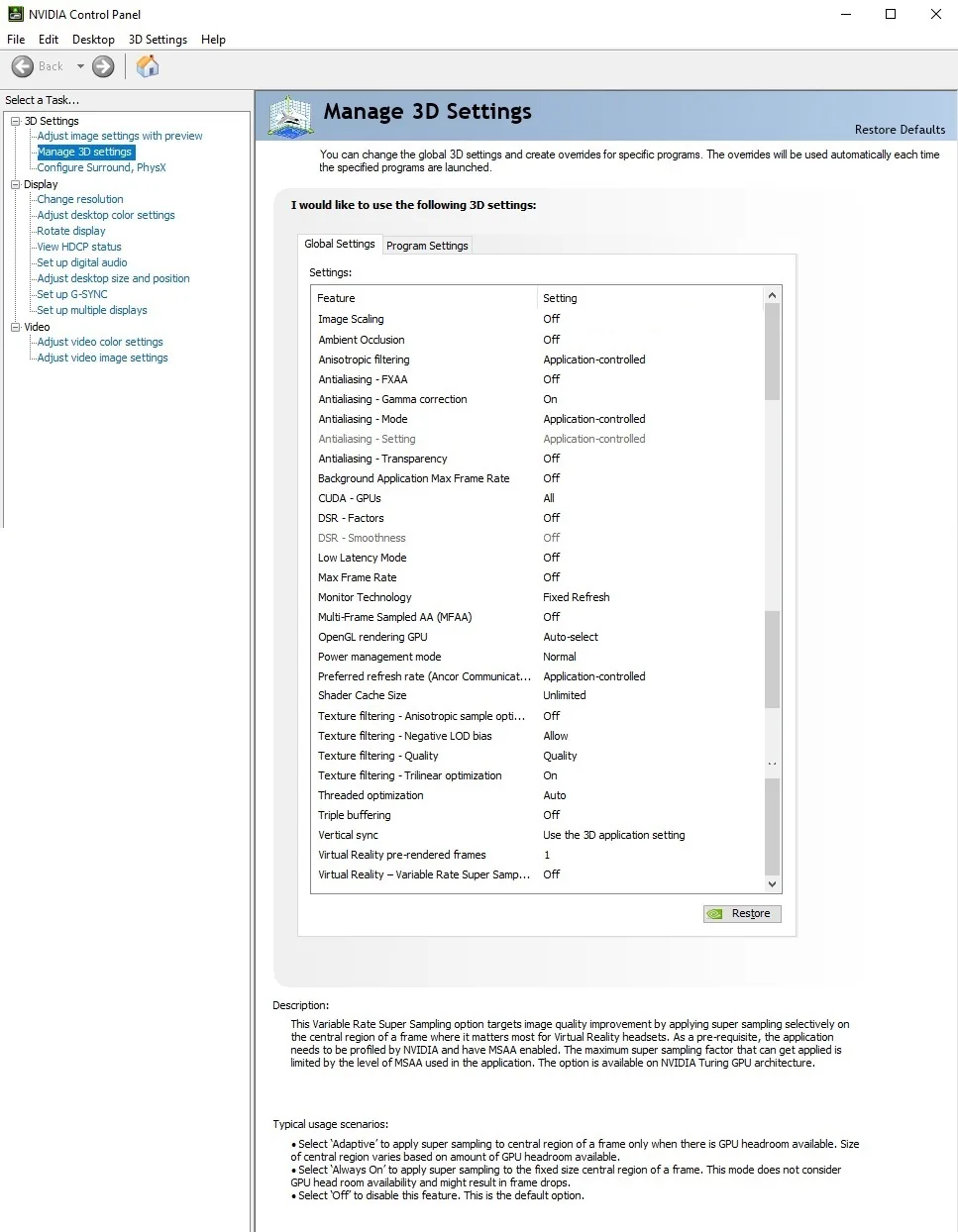
Both ‘High-Quality’ values for texture filtering-quality setting and ‘Prefer maximum performance’ for power management mode are set on a per-game or program profile-basis via Manage 3D Settings > Program settings tab.
Let’s head to our overclocking and benchmarking results.
CPU-Z and Overclocking
Overclocking the T-CREATE EXPERT DDR4-3600MHz CL18 2x16GB Kit
Before accepting the T-CREATE EXPERT 2x16GB DDR4-3600MHz CL18 memory kit for review, TeamGroup informed us that we should have no problem enabling and using its XMP profile on our Z690 CPU platform to run this RAM kit at its advertised frequency. So, we gladly accepted their review proposal and tried to confirm these expectations.
T-CREATE EXPERT DDR4-3600MHz XMP Profile
First, we enabled the T-CREATE EXPERT DDR4 3600MHz XMP profile (CL18-22-22-42 @ 1.35V) through our UEFI BIOS, and our system was able to POST and boot into Windows without issues. So, we can confirm that the advertised 3600MHz XMP profile of this memory kit is compatible with our Z690 CPU platform, and will likely be a viable option for other similar setups.
Here is CPU-Z showing the i9-12900K CPU report.
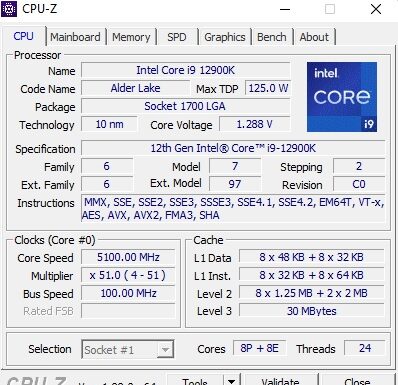
The T-CREATE EXPERT DDR4 default JEDEC and XMP profile timings and frequencies are shown below.
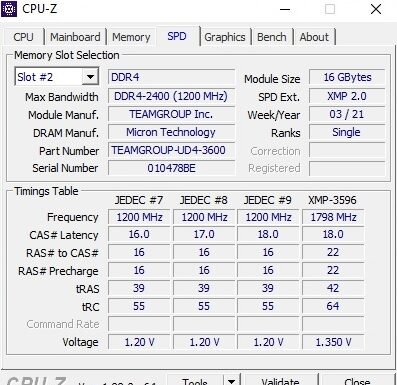
Below is the T-CREATE EXPERT DDR4 operating at its default 2400MHz JEDEC specifications.

Here are T-CREATE EXPERT DDR4 XMP clocks and details are shown below.

T-CREATE EXPERT DDR4-3600MHz XMP Manual Overclock
DDR4 Overclocking Approach
In this DDR4 memory kit review, aside from testing it with its XMP profile, we will also be increasing the DRAM voltage up to 1.4V max, and frequency in 200MHz increments until we find the highest achievable stable frequency for this kit. In the same way, DDR4 modules that use 1.4V/1.45V (XMP) will be tested up to 1.5V, and kits that operate at 1.5V up to 1.55V. Most DDR4 RAM kits can operate at higher voltages, but we don’t recommend doing so if you aim for a safe highest stable memory overclock.
We also considered increasing voltages and lowering timings instead of increasing the frequency of the modules as high as it can go, if stable and without going over 1.4V, but the real-world performance results are pretty much identical.
Highest Safe and Stable Overclock
T-CREATE EXPERT DDR4 manually overclocked to 3800MHz with CL18-22-22-42 XMP timings and 1.380V for stability is shown below.
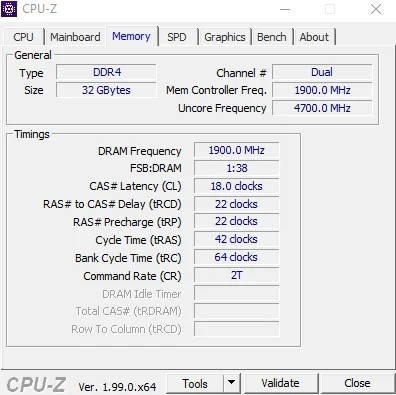
We used our self-imposed limit of 1.400V to stabilize the memory overclocks. After much trial and error, we finally settled on a maximum and stable overclock of 3800MHz by using a voltage of 1.380V and XMP timings.
We tested the overclock stability by using AIDA64 System Test, Karhu RAM Test, and OCCT Memory Test. These tests stress the memory and the CPU in search of memory errors. We also confirmed that our overclock to 3800MHz was stable by playing games and running other benchmarks.
It’s worth mentioning that we were also able to manually overclock our T-CREATE EXPERT DDR4 memory kit sample to 4000MHz and achieve stability.
Below is the T-CREATE EXPERT DDR4 manually overclocked to 4000MHz and operating with increased CL19-23-23-45 primary timings, Command Rate set to 1T, and DRAM voltage set to 1.450V for stability.
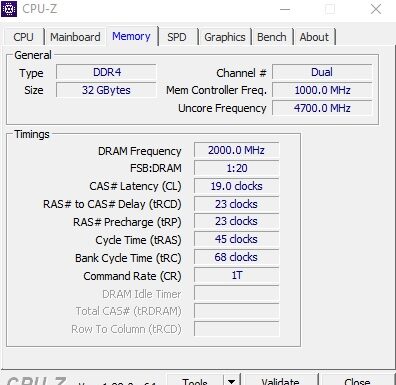
However, we ruled out this overclock to 4000MHz because we had to loosen the XMP primary timings to CL19-23-23-45, enable Gear 2 and XMP II BIOS modes, and increase the voltage to 1.45V, which exceeded our self-imposed RAM voltage limit. All these conditions overall resulted in worse efficiency, latency, and pretty much the same performance on real-world workloads and games as we got using our 3800MHz CL18 memory overclock.
Notes on T-CREATE EXPERT DDR4-3600MHz Overclocking
Taking into account the above, we believe that overclocking the T-CREATE EXPERT DDR4-3600MHz +200MHz from XMP-3600MHz specs to 3800MHz CL18-22-22-42 @ 1.380V is an efficient good overclock for Z690 users wanting safe daily use, stability, and improved performance using this DDR4 memory kit.
Our overclocking experience shows a relatively good or moderate overclock headroom for a DDR4 memory kit sample that already has relatively high XMP frequency and relaxed timings.
Next, the summary charts and performance notes.
Intel Z690 Performance Results
Below you can find the summary charts of our selection of PC games and synthetic, hybrid, and real-world benchmarks. We select games that are CPU-dependent and use a display resolution that makes them overall more CPU-bound.
You can see the list of games’ graphics settings on the charts, and we run each built-in game benchmark’s sequence at 1920×1080 (Full HD). You may click on each chart to open a pop-up for the best viewing.
T-CREATE EXPERT DD R4-3600 CL18 vs. T-FORCE XTREEM ARGB WHITE DD R4-3600MHz CL14
Synthetic Benchmark Charts
AIDA64 Extreme – Cache & Memory Benchmark
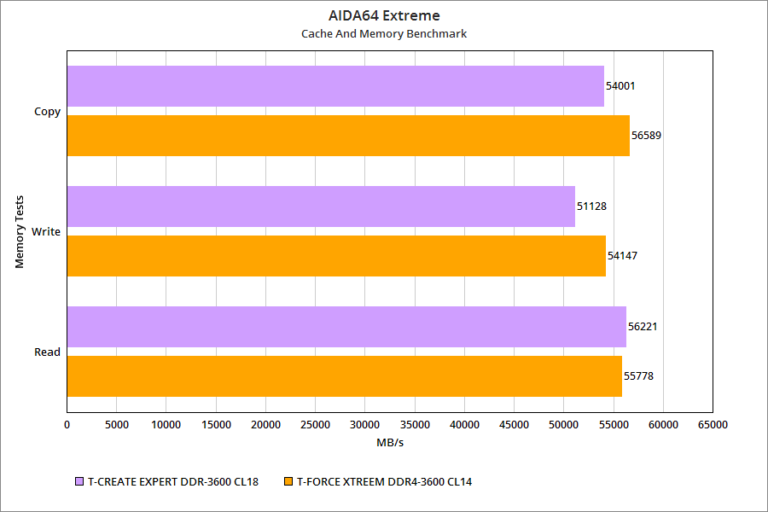
While the T-FORCE EXPERT DDR4 kit shows significantly lower performance in AIDA64’s memory copy and write tests, it performs roughly the same as the XTREEM DDR4 memory kit in the memory read test.
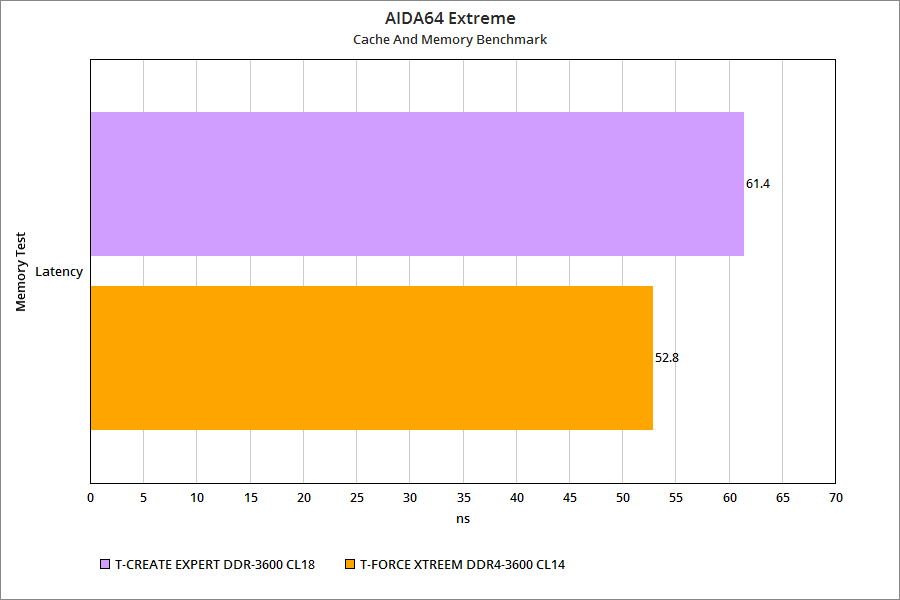
As expected, based on its lower XMP latencies, the XTREEM ARGB WHITE kit shows a significantly lower latency score than the EXPERT DESKTOP kit in the AIDA64 memory latency test.
Geekbench 5 – CPU Benchmark

Here we see a tie between both DDR4 memory kits in the Geekbench 5 single-core score, despite their XMP timing differences.
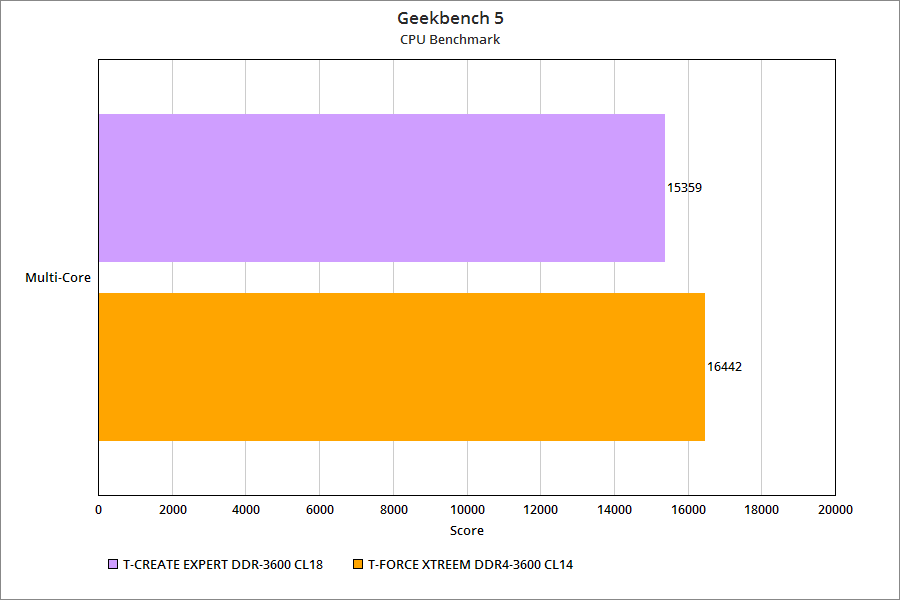
The T-CREATE EXPERT DESKTOP memory kit scores significantly worse than the XTREEM ARGB WHITE kit in the Geekbench multi-core test.
Novabench Test – Global, GPU, RAM, and CPU Test Scores

We see that the T-CREATE EXPERT DDR4 shows a slightly lower overall score than the XTREEM ARGB WHITE kit.
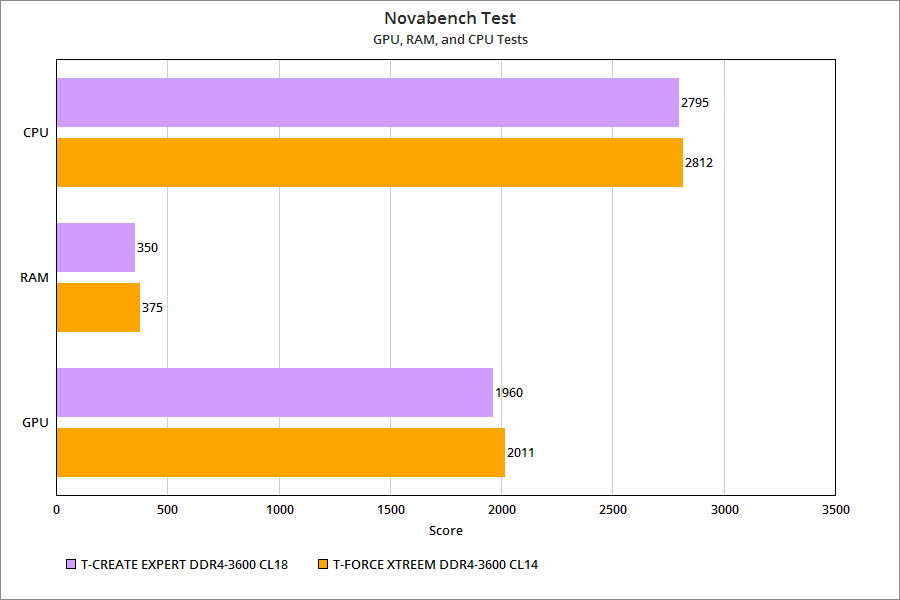
Here we see how the EXPERT DESKTOP memory kit scores worse than the XTREEM ARGB WHITE kit in all three Novabench sub-tests, although the RAM test shows the only significant difference.
SiSoftware Sandra 2021 – Memory Controller Tests

The T-CREATE EXPERT memory kit shows a remarkably worse memory bandwidth score than the T-FORCE XTREEM kit in the Sandra 2021 memory bandwidth test.

Here is the EXPERT DESKTOP memory kit showing a notably worse memory latency than the XTREEM ARGB WHITE kit in the Sandra 2021 memory latency sub-test.

We don’t see a significant difference between DDR4 memory kits in the cache/memory bandwidth FMA/256 sub-test.
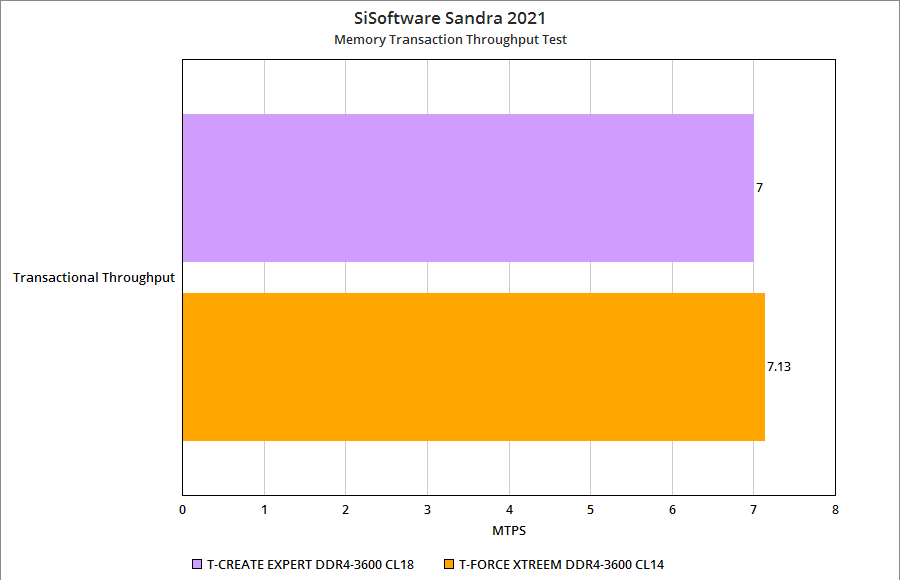
No significant performance differences were found between DDR4 memory kits when running this Sandra 2021 memory controller test.
Super PI Benchmark
It’s a benchmarking tool to calculate Pi (?) to a specified number of digits after the decimal point – up to a maximum of 32 million
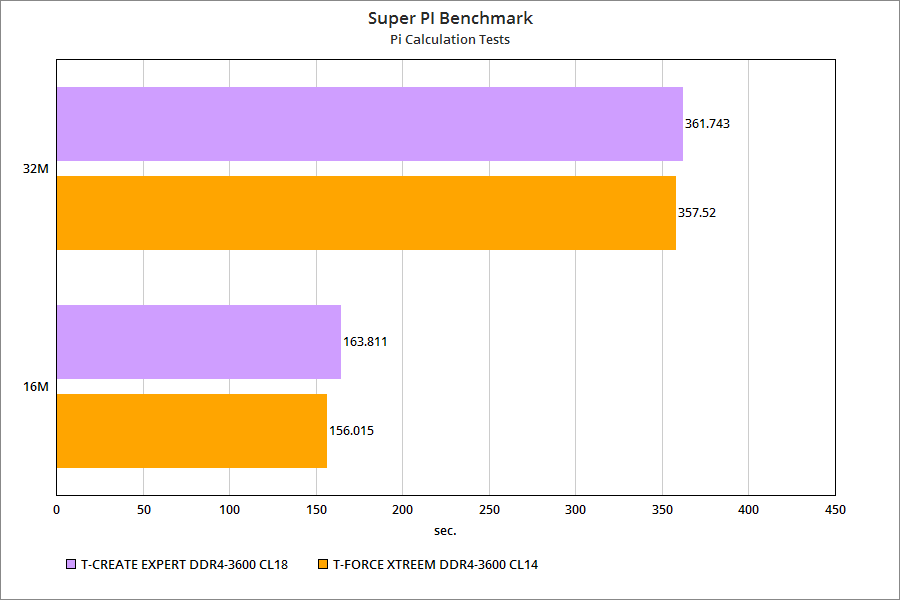
While we saw a remarkable performance difference in the Super PI 16M test between our memory kits, we didn’t in the 32M test.
wPrime Benchmark
It’s is a benchmarking program that performs calculations of a set number of square roots using Newton’s method for estimating functions verifying the results by squaring them, then comparing them with the original numbers (Wikipedia).
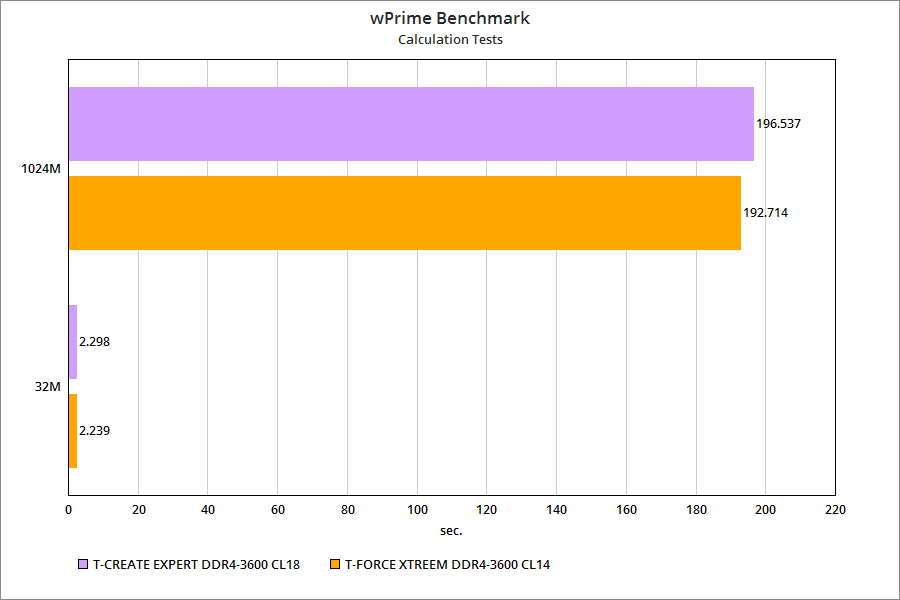
Although the T-CREATE EXPERT DDR4 memory kit performed significantly worse than the XTREEM ARGB WHITE DDR4 kit in the wPrime 1024M test, there weren’t significant differences running the 32M test.
7-Zip Benchmark
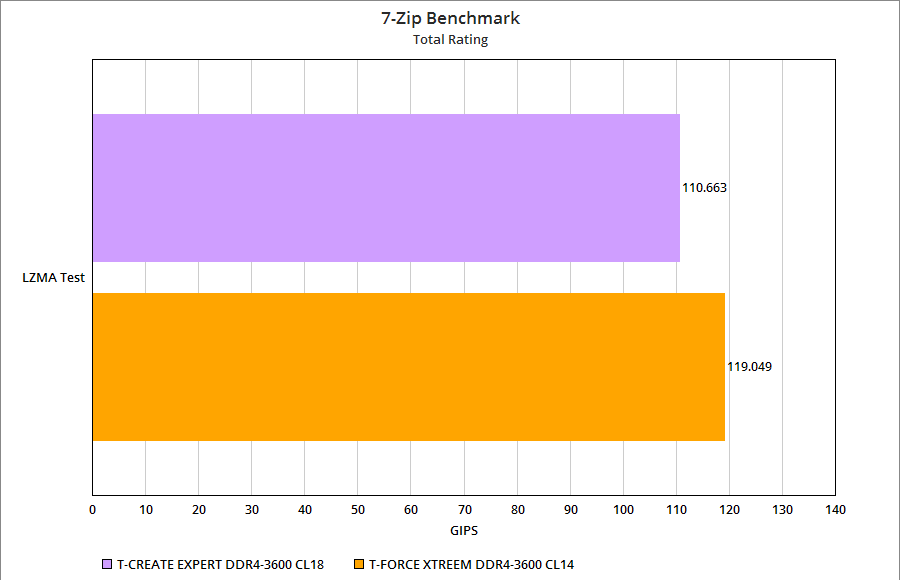
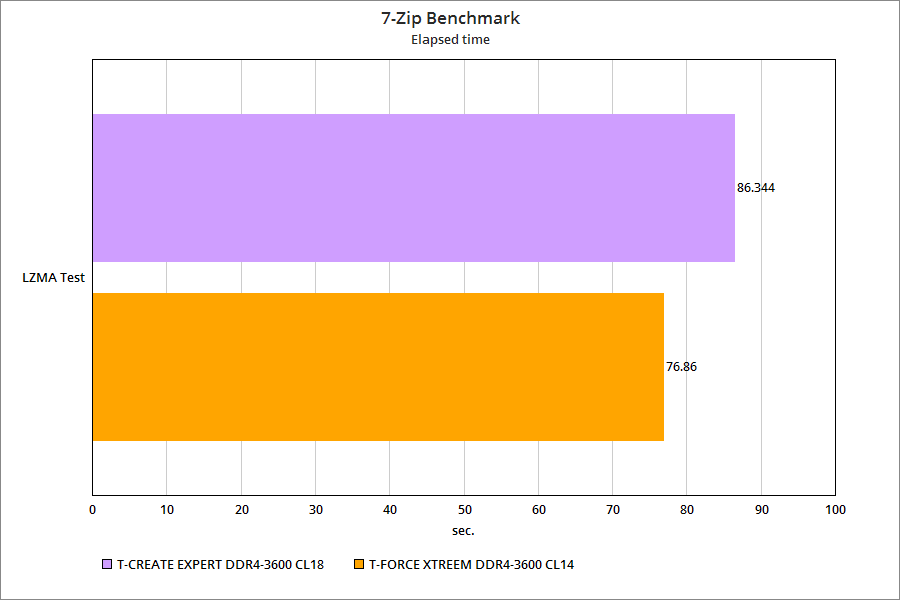
The 7-Zip LZMA is a memory-sensitive compression/decompression test and a good synthetic benchmark to compare DDR4 memory kits.
Our results in this test show that the T-CREATE EXPERT memory kit performs worse than the T-FORCE XTREEM kit, probably due to the higher EXPERT DESKTOP’s DDR4-XMP primary timings.
Hybrid Game Benchmark Charts
3DMark – Fire Strike (DirectX 11)
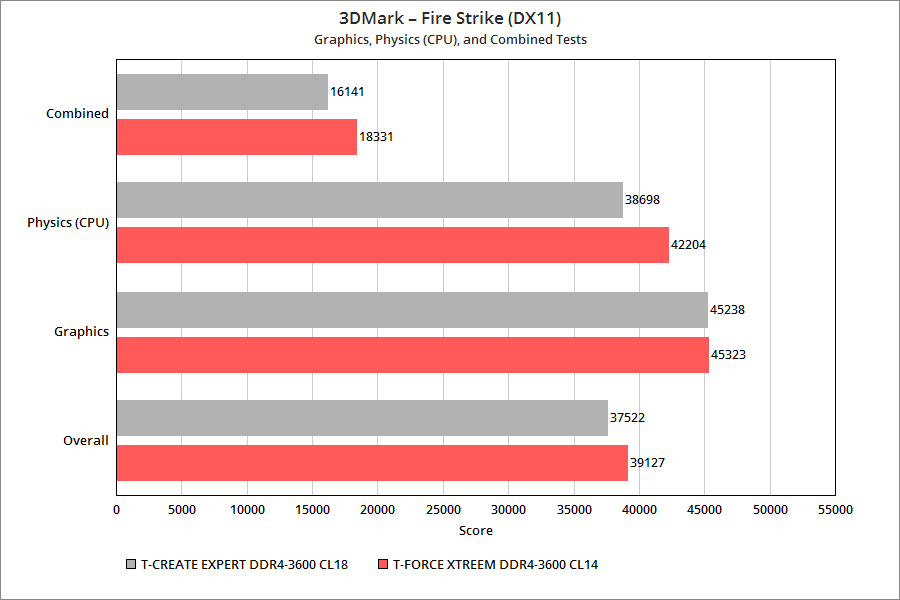
The T-CREATE EXPERT memory kit performed notably worse than the XTREEM ARGB WHITE kit in 3DMark’s Fire Strike Physics CPU and Combined tests. However, both DDR4 RAM kits performed overall the same in the Graphics test.
These results overall allow us to expect likely minor to moderate advantages of the T-FORCE XTREEM ARGB WHITE DDR4-3600 CL14 memory kit over the T-CREATE EXPERT DDR4-3600 CL18 kit when playing DX11 games, depending on the CPU-boundedness of a particular gaming scenario.
3DMark – Time Spy (DirectX 12)
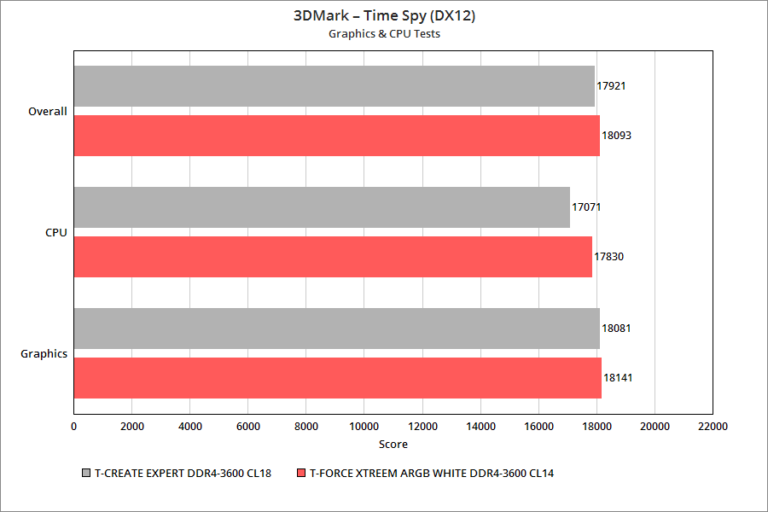
Although we see that the T-CREATE EXPERT memory kit performed notably worse than the XTREEM ARGB WHITE kit in the 3DMark Time Spy CPU test only, the Overall and Graphics scores didn’t show significant differences between both DDR4 memory kits.
Again, these results overall allow us to expect likely minor advantages of the T-FORCE XTREEM ARGB WHITE DDR4-3600 CL14 memory kit over the T-CREATE EXPERT DDR4-3600 CL18 kit when playing DX12 games, depending on the CPU dependency on a particular gaming scenario.
Later in this section, we will try to support this hypothesis by running our DX12 games and capturing and charting their performance figures using their corresponding built-in benchmark tools.
Non-Synthetic/Real-World Benchmark Charts
Blender Benchmark – All benchmark scenes (CPU)
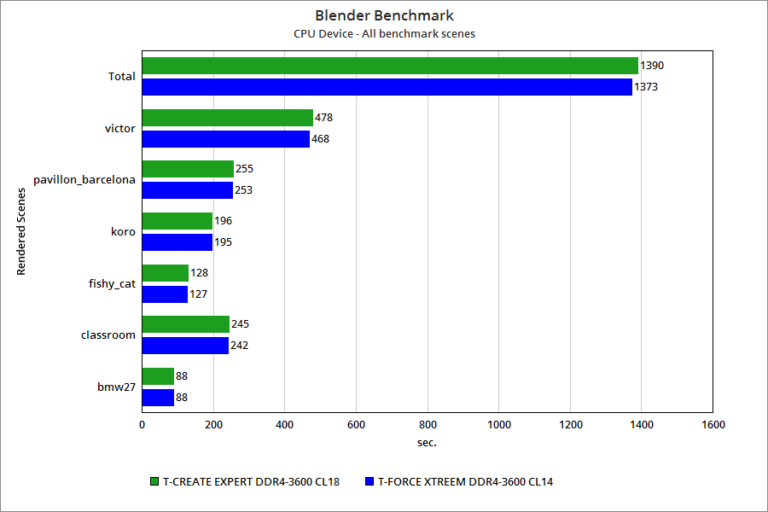
We see no significant differences in image render times using both DDR4-3600MHz memory kits to complete the Blender benchmark, rendering all scenes. So, we are faced with another case of a technical tie.
Cinebench R23 – CPU (Multi-Core) test & CPU (Single-Core) test
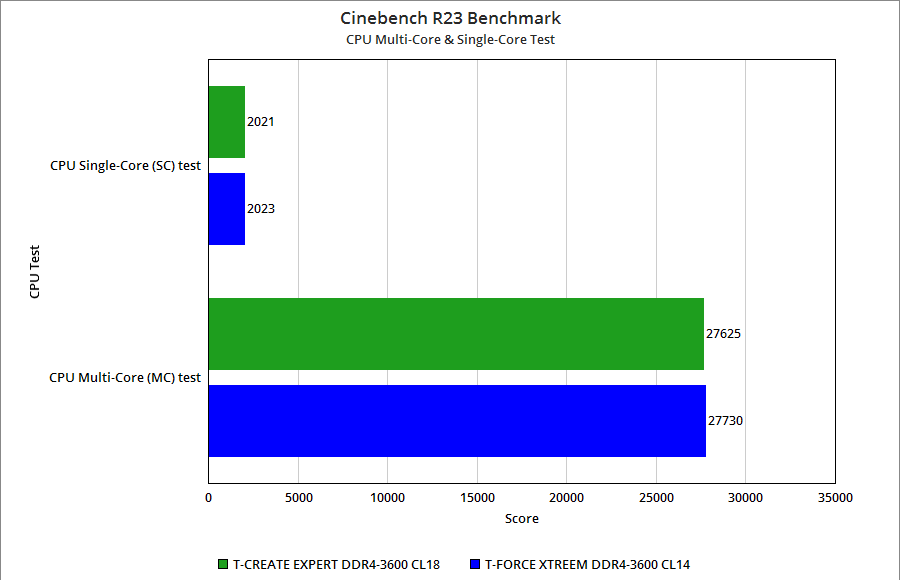
Here is another case of a technical tie in image rendering performance with both memory kits.
The T-CREATE EXPERT 2x16GB DDR4-3600MHz CL18 memory kit matches the image rendering results of the T-FORCE XTREEM ARGB WHITE 2x16GB DDR4-3600MHz kit that features significantly lower primary timings (CL14-15-15-35) and a higher voltage (1.45V).
The outstanding performance results using the T-CREATE EXPERT 2x16GB DDR4-3600MHz CL18 memory kit in demanding image rendering workloads confirm the excellent job made by TeamGroup when designing these T-CREATE memory modules targeted to 2D/3D creators.
Game Benchmark Charts – Using the games’ built-in benchmark tools
F1 2021 (DirectX 12 API)

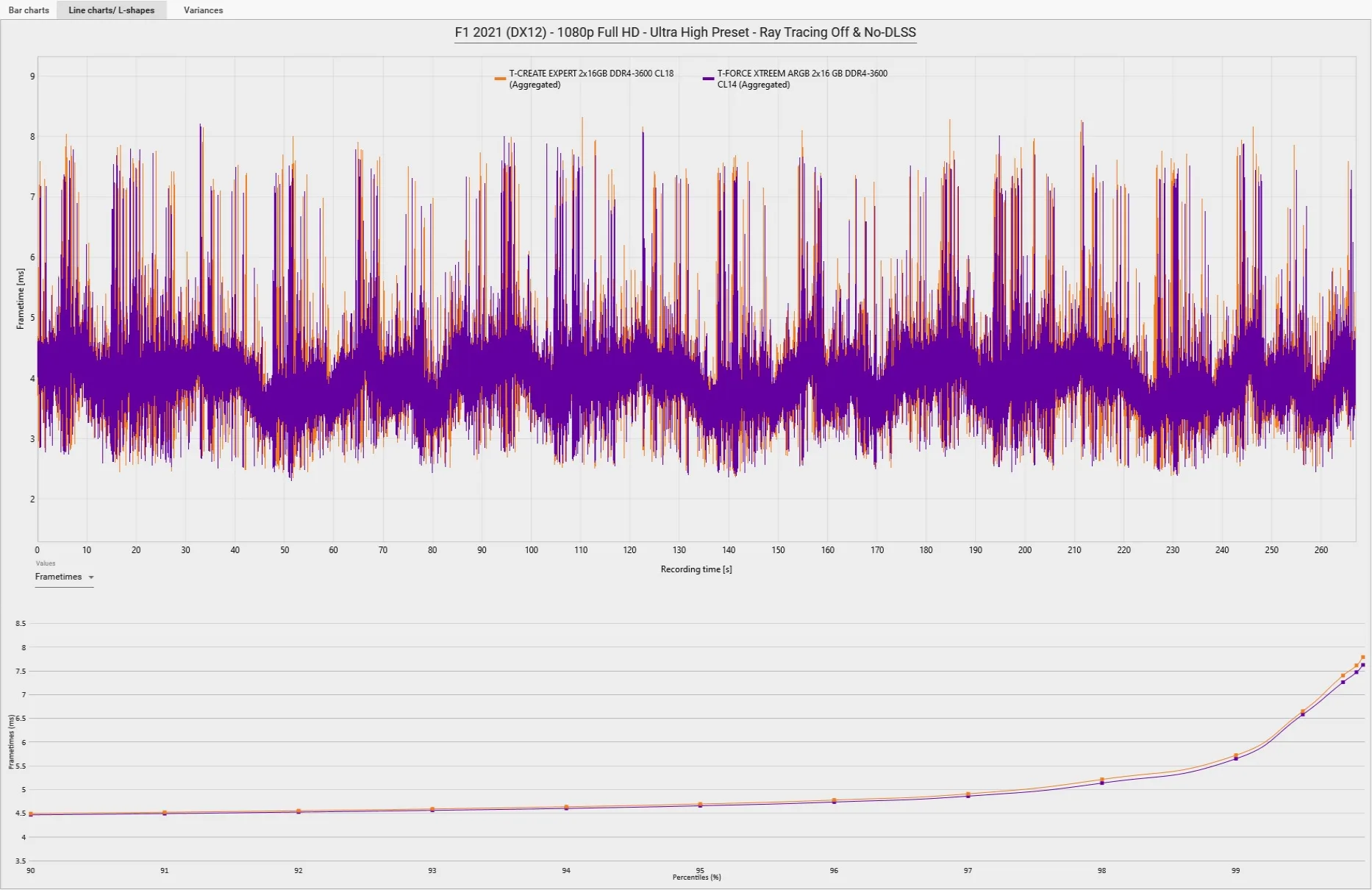
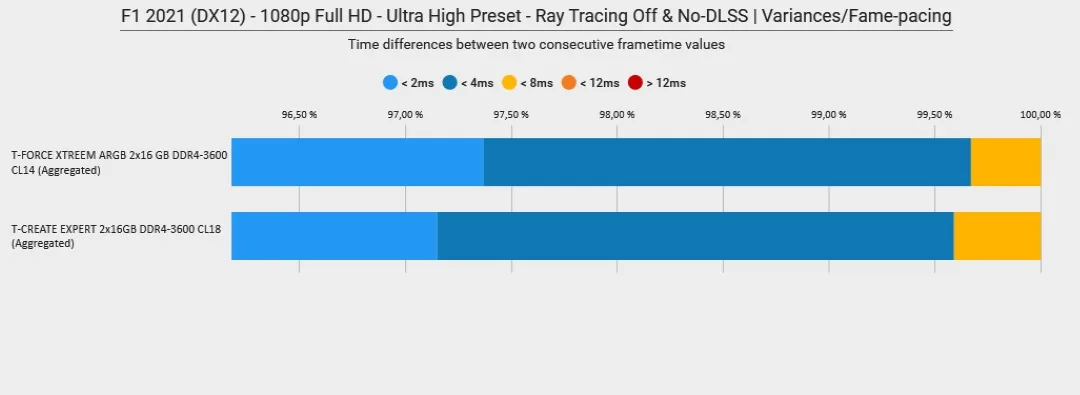
We saw no significant differences in raw performance and frametime consistency using both DDR4-3600MHz memory kits in F1 2021 (DX12). If we take a closer look, we see a slightly worse frame-pacing using the T-CREATE EXPERT memory kit that could be due to their higher CAS latency and XMP timings, but the difference is unnoticeable while playing.
Therefore, this is overall a tie case between both DDR4 memory kits.
Far Cry 6 (DirectX 12 API)

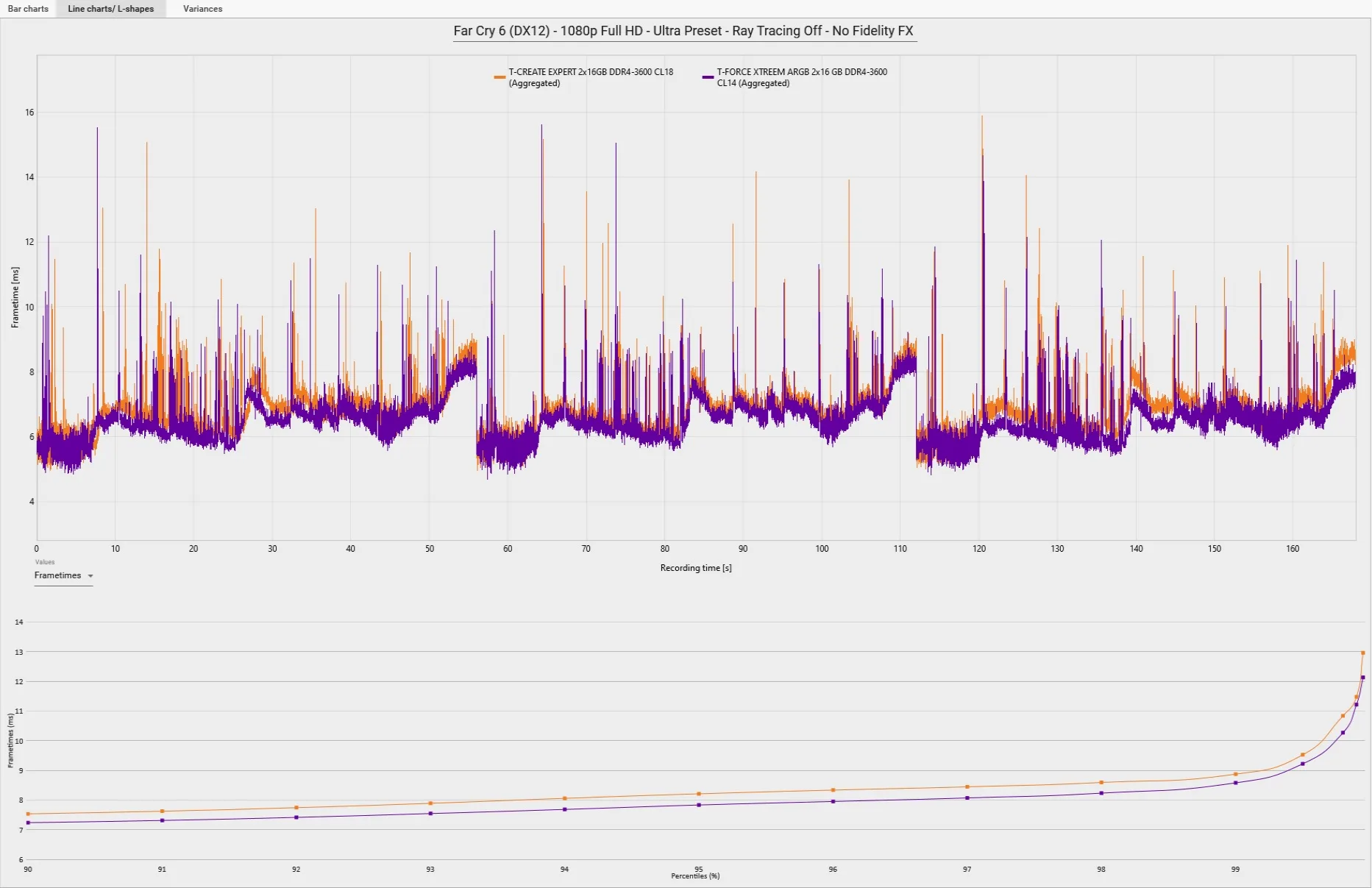
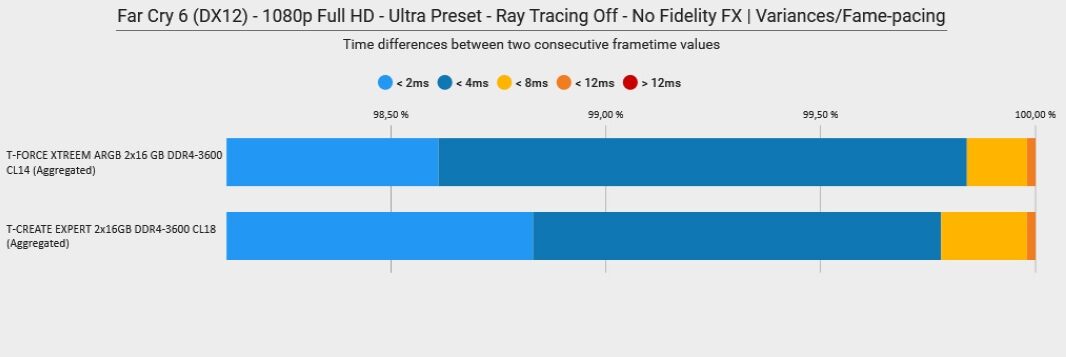
In this game, the T-CREATE EXPERT memory kit performed significantly worse than the T-FORCE XTREEM ARGB WHITE kit both in terms of raw performance and frametime stability, but not by a wide margin. The frame-pacing was also slightly worse using our EXPERT DESKTOP DDR4 memory sample.
However, the Far Cry 6 performance results using the EXPERT memory kit were overall good if we consider its higher memory timings.
Horizon Zero Dawn (DirectX 12 API)

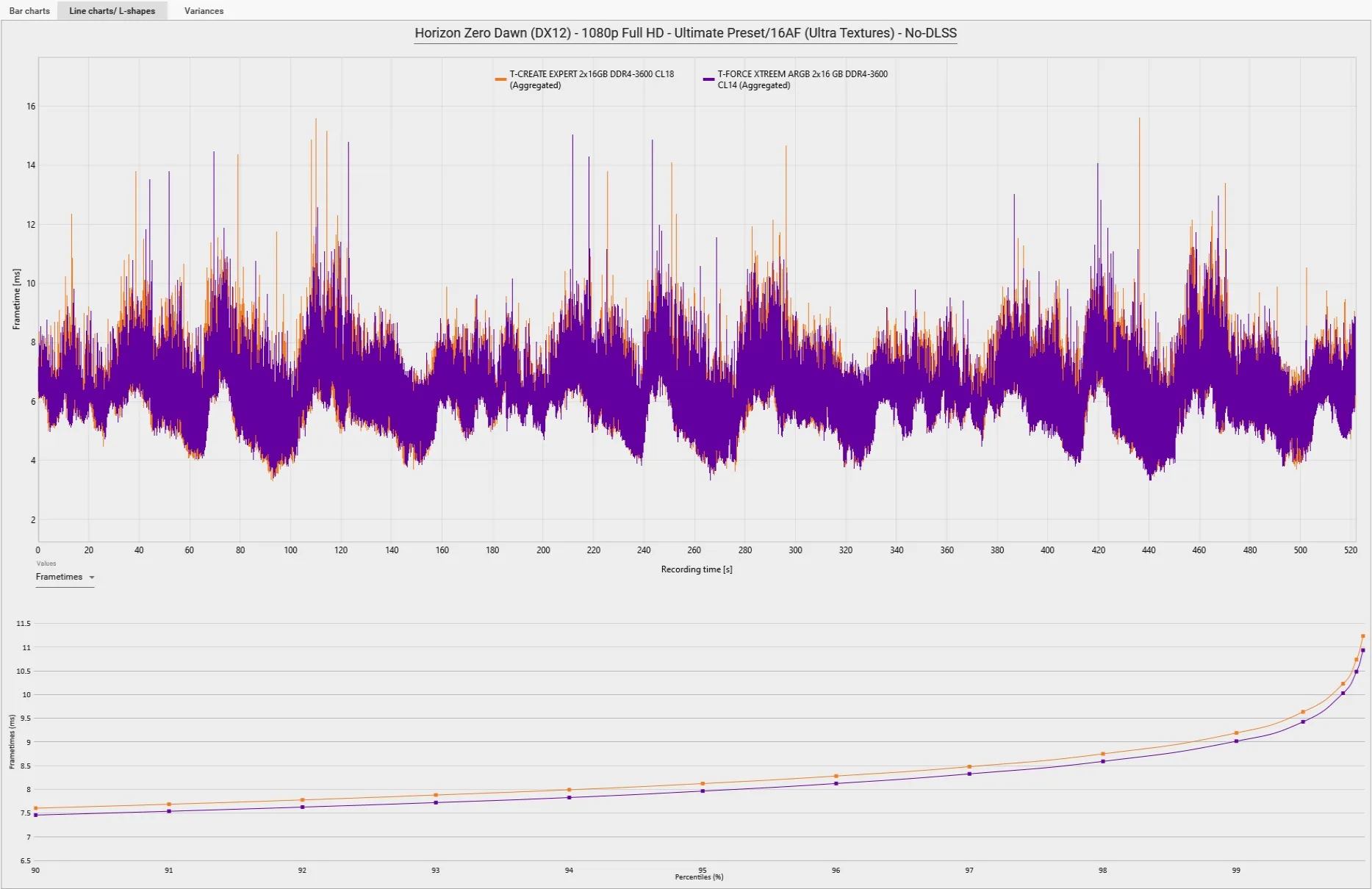
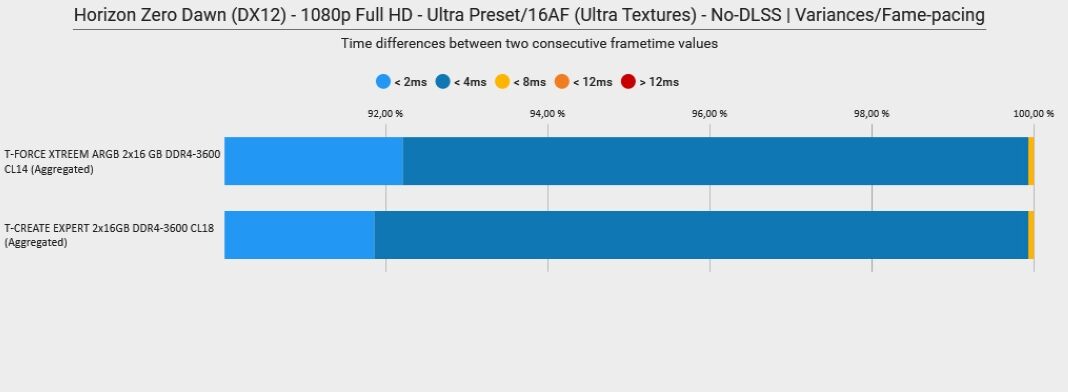
Here is a case of a technical tie in gaming performance with both memory kits. It’s good news!
T-CREATE EXPERT 2x16GB DD R4-3600MHz CL18 Performance Notes
From the charts, while we see an inferior performance in most synthetic tests using the T-CREATE EXPERT 2x16GB DDR4-3600MHz CL18 memory kit, we also see pretty much identical performance in both hybrid graphics and real-world benchmarks using both DDR4-3600MHz kits.
For gaming benchmarks, F1 2021 and Horizon Zero Dawn show no significant performance differences with approximately the same performance using both memory kits. Far Cry 6 is the only game with worse performance using the T-CREATE EXPERT memory kit, but not by a lot and granting an overall good gaming experience anyway.
Disclaimer
Please be aware that the following results, notes, and the corresponding product evaluation are valid for similar i9-12900K/Z690 gaming platforms on Windows 11 v21H2. Its representativeness, applicability, and usefulness on different CPU platforms, testing benches, and MS Windows versions may vary.
Conclusion and Verdict
We highly recommend the T-CREATE EXPERT DESKTOP DDR4 OCL10 2x16GB 3600MHz CL18 for i9-12900K/Z690 users, professional creators (also those who want to play eventually), or conservative gamers who want an affordable, quality, high performance, solid, sober, and versatile DDR4 memory kit.

There are some key questions we tried to answer in this review, and that is why we put them back on the table for summarizing our answers to them after our testing. The first two questions arise more from checks of two statements from TeamGroup’s advertisements on the T-CREATE EXPERT memory kit than from an original personal questioning. So here are the questions and the answers that we can now share with you.
Is our T-CREATE EXPERT 2x16GB memory kit sample made for creators?
We are glad to say that it is. The T-CREATE EXPERT performance and power efficiency are excellent to the point that we were able to run demanding image rendering applications and related benchmarks without the need to apply a high voltage or need lower latencies to get great results.
Is large capacity, overclocking, and stability all-in-one a fact after testing our EXPERT DESKTOP DDR4 memory kit sample?
Our answer here is also positive. 32GB of high-performance DDR4 RAM is considered an affordable, reasonable, and future-proof option for gamers and creators. The T-CREATE EXPERT sample we received features 32GB (2x16GB), so we consider it a large capacity kit. Also, our experience applying and running its XMP profile was seamless, without any compatibility or stability issues. The manual overclocking experience was also satisfactory since we achieved an efficient, safe, and stable 3800MHz CL18 1.38V overclock that further improved over its good 3600MHz XMP starting performance.
Finally, is the T-CREATE EXPERT DDR4-3600 CL18 worth it for gaming?
I’d say these things always come in threes because our answer to this question is also affirmative. The EXPERT DESKTOP DDR4 performed very well in both hybrid gaming benchmarks and games, showing overall a similar gaming performance to our premium T-FORCE XTREEM ARGB WHITE 2x16GB DDR4-3600MHz CL14 1.45V gaming memory kit.
Worth mentioning is the operational efficiency of its relatively high stock frequency of 3600MHz, the lower voltage of 1.35V, and higher XMP timings than the more expensive – and likely less efficient – T-FORCE XTREEM ARGB WHITE memory kit. So for its reasonable price, good build quality, large capacity, high performance, and versatility, the T-CREATE EXPERT DDR4 is a memory kit that creators and gamers should consider as a purchase option.
Let’s Play!
***
Rodrigo González (aka ‘RodroG’) is an enthusiast gamer and tech reviewer especially interested in shooter games, open-world role-playing games, and software and hardware benchmarking. He is the author of the NVIDIA WHQL Driver Performance Benchmarks Series and founder and moderator of the r/allbenchmarks community on Reddit.
